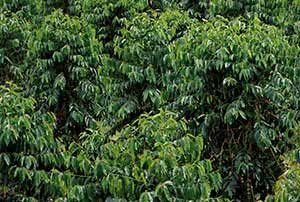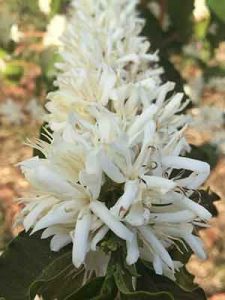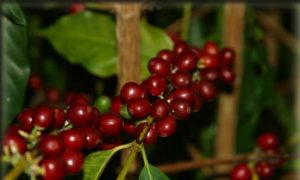
Learn about Kona Coffee production and farming
“I have measured out my life with coffee spoons.” -T.S. Eliot
Kona Coffee Farms

There are approximately 650 – 700 independent estates in North and South Kona farming Kona Coffee trees. As a result about 20,000 to 40,000 pounds of Kona cherries are produced for every 3-5 acre Kona Coffee farm. Also after milling, each 10,000 pounds is reduced to 2,000 of viable beans.
Most Kona Coffee farms are about 2-7 acres in size. Today, many Kona Coffee farmers proudly claim to be 5th generation descendants of the original Kona Coffee farmers.
Kona Coffee Trees

The Coffee “trees” are actually classified botanically as bushes. The coffee-industry, however, refers to these bushes as Coffee Trees. Coffee trees begin to bear fruit after 2 to 3 years.
Kona Snow

Each tree has dark green, glossy leaves and clusters of fragrant white flowers that bloom simultaneously. These clusters are affectionately known as “Kona Snow.” If allowed, a coffee tree can grow to more than 30 feet tall. However in Kona they are pruned annually to encourage cherry production and make harvesting easier. The pruned trees take 1-2 years to reach full production. For this reason farmers only prune selective trees annually. Kona coffee trees typically bloom from January to May.
Kona Coffee Cherries

The coffee cherries start showing up in April. A coffee cherry is the sweet, pulpy fruit that the coffee tree produces. The cherries contain the the beans. The cherry is oval, about 1.5 cm long. Ripening takes about 8 months – the cherry starts a green color and, as it ripens, turns yellow, then crimson, and finally a dark red, indicating it’s ready for harvest. Harvest usually begins at the end of August. A good coffee tree produces about 25 pounds of cherries.
Handpicking Kona coffee
All coffee beans in Kona must be handpicked. Accordingly, another expense added to the high cost of production. Machine picking cannot be done on the the rough volcanic terrain. Also, the cherries ripen at varying times so they are selectively picked. While some cherries are ready for picking, others need to be left to ripen. Consequently this results in high quality beans being picked.
